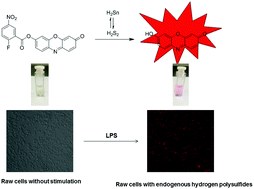A resorufin-based fluorescent probe for imaging polysulfides in living cells†
Abstract
As the oxidative metabolites of the endogenous gasotransmitter H2S, H2Sn have attracted ever-increasing attention in the field of biomedical research due to their vital functions in biological systems. Herein, we report a resorufin-based “turn-on” probe for H2Sn sensing. An SNAr substitution–intramolecular cyclization cascade reaction was used in this probe for detecting exogenous and endogenous H2Sn. The detection process could be monitored using UV-Vis and fluorescence spectroscopy and the naked eye. The emission response of the probe towards H2Sn presented a good linear relationship in the 0–50 μM concentration range, and the LOD of this probe was 24 nM. The probe was used successfully to visualize endogenous H2Sn generated in the RAW 246.7 cells under external stimulation.



 Please wait while we load your content...
Please wait while we load your content...